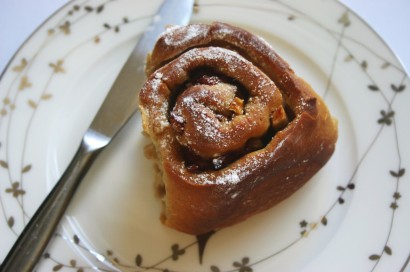No Reviews
You must be logged in to post a review.

If you like chelsea buns (cinnamon rolls) then you’ll probably like these. Sweet, cinnamony-bread filled with plum and apple pieces.
Put the flour, salt, sugar, cinnamon and yeast in a bowl and mix together thoroughly.
Scald 1/2 a cup of the milk (basically heat it until just before boiling point – don’t worry if it does reach boiling point – it will still be okay to use), pour the hot milk back into your measuring cup, and top it off with the remaining milk to make a full cup. The milk should be lukewarm at this point – if it is too hot, set it aside for a minute or two, or pour a bit of warm milk out of the cup and top it back up to a full cup with cold milk.
Add the lukewarm milk to the dry ingredients and mix together. Knead for a minute or so in the bowl (don’t be surprised if it is very sticky), and then cover with a clean, damp tea-towel and leave somewhere warm to rise until the dough has at least doubled in volume. This may take up to an hour, depending on how warm it is wherever you leave the bowl.
When the dough has risen, tip it onto a lightly floured, clean surface, and knead it for four or five minutes. When you’ve finished kneading the dough, roll it out into a long rectangle (you might need to lightly flour the surface again, as well as the rolling pin). It doesn’t matter how long the rectangle is, but it should be about 20 cm wide (a bit more than that is fine) and half a cm thick. It doesn’t matter if it isn’t a perfect rectangle – just aim for a minimum width of 20 cm.
Generously brush the top of the rolled out dough with the melted butter or margarine (you probably won’t need all of it).
Put the chopped fruit onto a couple of pieces of scrunched-up kitchen towel to absorb some of the juice, and then evenly spread the chopped apples and plums across the top of the dough. Leave about an inch of the dough uncovered (at the bottom of the rectangle), to ensure that it will stick together nicely when you roll it.
Carefully, and tightly, roll the dough along its length. Work lengthwise, starting with the end opposite the border that you left without fruit. The easiest way to do this is, using both hands, to roll it just a little way, starting from one end and working to the other end, before going back to the first end and rolling it another little bit across its length. As you get to the end of the dough with the border without fruit, push any stray bits of fruit into the inside of the roll with your thumbs as you finish rolling. When you’ve finished, the final product will look a bit like a long sausage roll that you’ve not yet cut into little sausage rolls. Next, cut off the jagged ends of the long roll, and then cut the roll into evenly-sized smaller rolls. I cut 10 rolls from my long roll, but the number you get will depend on how wide you cut them.
Carefully put the rolls into a greased pan (grease the sides and the bottom of the pan), with one of the open-sides of the roll face down. I used a 9-inch diameter round cake tin for all 10 rolls and the two end pieces (no point in wasting them!). You might need to push each roll downwards slightly as you put it into the tin so that it doesn’t fall over. Leave at least a centimetre between each roll.
Cover the pan with a clean, damp tea towel again and leave to rise for a second time. When the rolls have risen, pre-heat the oven to gas mark 5 (190º C or 375º F) and then bake in the middle of the oven for about half an hour, or until golden brown on top. When the rolls have baked, take them out the oven and immediately sprinkle them with icing sugar (or a glaze if you prefer), before setting aside to cool. Cooling in the tin should be fine.
No Comments
Leave a Comment!
You must be logged in to post a comment.